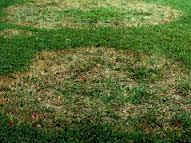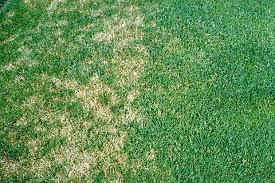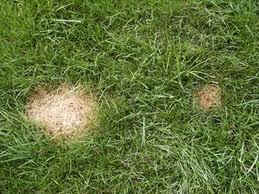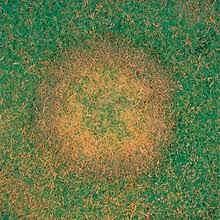Lawn Mould and Fungus
It comes in many forms: irregular brown patches, unsightly gray splotches, stringy red threads, a dusting of orange-red powder, and more. Regardless of the specifics, however, when a lawn fungus strikes your lawn, you must take prompt action to prevent it from spreading and destroying your grass. Many post-disease treatments double as preventative measures and involve improving the drainage and air flow of your soil. Prevention, in fact, is the best treatment against lawn fungus. You can also apply various fungicides, both chemical and organic, to aid your lawn in its efforts to fight back against the disease. |

|

|

|

|
Maintaining a healthy and well-tended lawn is the best way to prevent fungal infections from damaging the appearance of your grass. If your lawn doesn't get adequate water and fertilizer or if you mow it incorrectly, infection can begin and spread throughout the grass. Knowing the symptoms and appearance of a lawn infected with fungi will help you take immediate steps to remedy the situation and maintain the health and attractiveness of your grass.
A healthy lawn can withstand the presence of fungi without being vulnerable to damage. For a fungal disease to occur, your lawn is lacking an important component of good health. Grass is more susceptible to fungal infections if it doesn't receive adequate water regularly. A lawn that is not fertilized regularly also faces an increased risk of a fungal infection. In addition, extreme temperatures can increase the risk of fungi damage to your lawn. One
example of why fungus keeps re-occurring is that swimming pools and
the surrounding patios harbor the spores that are then transported
on the feet of swimmers onto the grass area. So before starting any
lawn treatments, make sure your pool
surrounds and garden furniture are clean.
But
there are many other reasons why fungus keeps re-appearing. See
more..:![]()
There are many other reasons, but for more help and a solution to your problem on this complicated and very frustrating problem, please contact us.
Hide this content.
When a fungal infection is present, you will notice the blades of grass suffering damage. Brown or purple stripes often appear on the individual blades of grass when your lawn is infected with a fungus called Bipolaris sorokiniana. Blades of grass that look like they have a layer of dust or white chalk on them is a symptom of powdery mildew caused by the fungus Erysiphe graminis. And Ustilago striiformis, or stripe smut, causes the blades of grass to turn black and split.
Other types of fungi can cause distinctive patterns of damage throughout your lawn. Magnaporthe poae causes summer patch, which leaves circles of yellow throughout your lawn. The fungus Rhizoctonia cerealis causes yellow patch, which leaves smaller circles of yellow. Fairy ring, caused by numerous different fungi, leaves a dark green section of grass surrounded by a ring of brown or dying grass. Microdochium patch, caused by the Microdochium nivale fungus, leaves pink circular patches in your lawn. Spring dead spot, Rhizoctonia large patch and Pythium blight also cause circular patches of brown or yellow grass.
Treatment and Prevention tips...![]()
Water your grass regularly, but don't water it too much because waterlogged grass invites fungi. Very dry grass also makes your lawn more susceptible.
Complete details are supplied in our Customised Lawn Fungus Project.
Hide this content.
Fairy Ring: This lawn fungus tends to leave ring formations of dark green and/or dead grass. In more extreme cases, you may even see patches of brown mushrooms. Fairy ring flourishes especially near dead vegetation such as tree stumps and thatch.
Rust: Light green to yellow to brown grass is the calling card of rust fungus. Heavy dew and excessively warm, moist weather helps spurn the growth of this fungus.
Pink Snow Mold: Identified by brown patches and yellow grass showing white or pink fungus spots after heavy rains. Heavy snow covers often associated with hills or banks can often lead to this fungus.
Slime Mold: White, yellow, or gray slime shows the presence of slime mold that clings to grass and occurs during prolonged wet periods. Slime mold also likes grass that has been left
unmowed.
Complete step
by step details can also be found in our Customised Lawn Fungus Project.
![]()
Lawn Fungus Prevention...![]()
The best plan for dealing with lawn fungus is to do everything you can to prevent it. By the time you see noticeable signs that lawn fungus has infiltrated your lawn, it will probably be extremely difficult to control. More than half your lawn you may be destroyed seemingly overnight. Few fungal spores have easy fixes, but most instances of lawn fungus can be avoided with a few lawn maintenance tips.
The most common mistake homeowners make is to overwater their lawn. It seems counterintuitive, especially during the hot, summer months, but overwatering your lawn can be more harmful to your lawn that not watering it at all. Just as important as how much you water your lawn is the time of day you do it. Most homeowners water their lawn when they get home from work or later in the evening. This can leave your lawn damp for hours, allowing fungus to get a foothold in your yard. Watering your lawn in the morning will allow the sun to quickly evaporate any excess water. If you don't have the schedule and/or the discipline to water your lawn in the morning, you should invest in a lawn irrigation system with a timer. These systems are going to be cheaper in the long run than treating your lawn for disease.
Over-fertilizing and over-seeding are also big problems. Between the soft, lush blades created by high nitrogen levels and the thick texture of dense grass blades, fungal spores will find it easy to jump from blade to blade as they are dispersed. At the very least, talk to a lawn care company about using fungicide in accordance with your lawn fertilizer. Keep in mind that no lawn care is perfect, and some preventative measures for lawn fungus may create other problems. Only a comprehensive lawn care program will help keep your lawn free of fungus, insects, weeds, and diseases all at the same time.
Hide this content.
Different fungal spores may require different treatments. In some cases, you may be able to remedy the problem with simple mowing and raking in conjunction with a specific watering pattern. More likely, you'll need to treat your lawn a fungicidal treatment. Unfortunately, many kinds of lawn fungus quickly develop a resistance to even the best fungicide. Given the worst-case scenario, you may need to re-sod or re-grow your lawn with a different grass if fungus begins to take over.
Complete step
by step details can also be found in our Customised Lawn Fungus Project.
![]()



